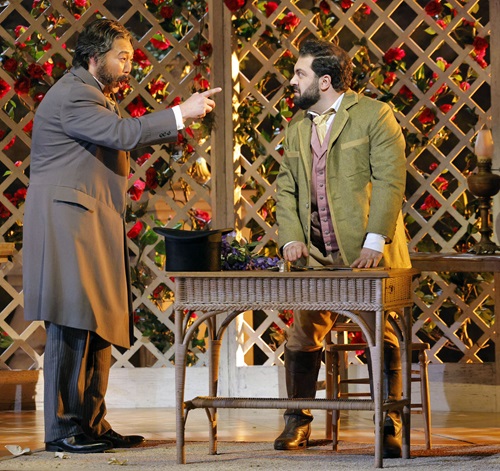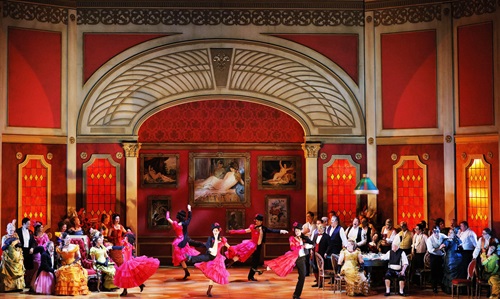At the Dorothy Chandler Pavilion, the LA Opera’s sumptuous performance of Giuseppe Verdi’s opera shows how women always seem to get the short end of the stick in tragic storylines.
By John Lavitt
Los Angeles, CA (The Hollywood Times) 04-08-2024
In La Traviata, Violetta Valéry is a high-class Parisian courtesan who falls in love with Alfredo, an idealistic nobleman better with ballads than bank accounts. As Violetta, American soprano Rachel Willis-Sørensen is the soul of the new production by the LA Opera. However, she is a doomed soul, and her plight reveals the cruelty of women’s fates in traditional operatic storylines. Why do women always get the short end of the stick?
Triumphant as a heroic Desdemona in Otello last year on the same stage, Rachel Willis-Sørensen gives another stunning performance in La Traviata. The staging, conducted with verve by James Conlon and directed by Shawna Lucey, allows Violetta’s volatile emotions to capture the audience’s hearts. Indeed, her presence captures the crowd’s gaze when she is on stage.
Played by Armenian tenor Liparit Avetisyan, Alfredo Germont, her impetuous lover, alternates between declaring his love and being self-involved. Although his proclamations are poetic, the character’s actions are insensitive and selfish. Ultimately, he cares more about appearances and his reputation in society. It is hard to imagine how he spends so much time with Violetta without realizing she is sick. After all, she is based on Marie Duplessis, a Parisian society courtesan who died of tuberculosis five years before the opera premiered. She was only 23 years old.
Moreover, La Traviata translates to “The Woman Led Astray.” If Violetta Valéry is a woman led astray, she is cursed as much by cruel fate and the even crueler libretto by Francesco Maria Piave. Indeed, the storyline curses her with an illness from the outset that is never specified but always clearly doomed to a fatal outcome. No matter how much Violetta is willing to sacrifice for the dream of love, her sacrifice is doomed to failure. Like the heroic Desdemona in Otello, the virtuous actions of the character mean nothing in the face of the cruelty of both men and their masculine deities.
Once again, Rachel Willis-Sørensen proves that she is at the top of the class of modern American sopranos regarding singing and acting ability. She captures Violetta’s plight with a resigned acceptance, making the tragedy even more bitter and hard to swallow. Accepting her doomed fate, she does not cower like a flower in a hurricane. Instead, she puts on a brave face and does her best to satisfy the desires of those around her. From the beginning to the end, she is the finest courtesan in town.

Still, her fate is unfair, reflecting the cruelty of operatic storylines regarding women. While the men seem to escape unscathed to desire and posture another day, the women are consistently screwed over. Okay, yes, such a phrase is brash and colloquial, but it truly captures the essence of what is happening on stage. The male-centric focus of La Traviata leaves the main female character to suffer and die for the sins of a patriarchal society and culture.
In relation to both justice and talent, the best male presence in the play is South Korean baritone Kihun Yoon as Alfredo’s father, Giorgio Germont. With a voice that takes your breath away, Kihun Yoon takes over the second act, proving to be a formidable presence on stage. Indeed, as the most noble male character, he almost redeems the play’s entrenched patriarchy.
Giving in to the demands of a judgmental society, he desperately wants to save his family’s honor. Thus, he knows his foolish son cannot spend his days with the dying courtesan. If Alfredo Germont succumbs to his impetuous desires, the family will be bankrupt and destroyed. Only in the end, when he realizes his mistake, does Giorgio Germont mourn the loss of the woman who truly loved his son. Yes, she was a courtesan, but she also was a damn fine human being.

As a final note, Robert Innes Hopkins’s production designer, responsible for the scenery and costumes, needs to be highlighted. From the first scene to the last, the production design is nothing less than breathtaking. Hopkins creates a sumptuous feast of outrageous outfits, architectural flourishes, floral arrangements, and erotic paintings to capture the decadence of an indulgent age.
When you combine such a visual feast with excellent singing and acting, the LA Opera’s 2024 production of La Traviata is a performance that should not be missed. Indeed, it might even allow you to forgive the patriarchal prejudices of the source material.
Photos by Cory Weaver Courtesy of the LA Opera





